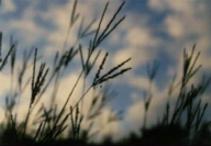

Common Names: Turkey
Feet, Beard Grass
Genus: Andropogon
Species: gerardii

This grass is also called Turkey feet because the shape of the seed heads look like turkey feet. It is also called beard grass. The name big bluestem grass comes from the fact that this grass can grow to very big, 3 to 10 feet as a matter of fact. It blooms from June through September.
Big bluestem is known as a bunch grass because it grows in little hill shapes. This grass forms 3 inch bronze to purple or green seed heads. The tall and slender stems are blue-green in the summer.
The hairy blades, which can get to be 12 inches long and 1/2 inch wide, will get a red tinge on the leaves as they get older, and turn bronze in the fall.
Big bluestem grass grows in dense stands. This keeps other grasses from getting any sun and growing. As a result there are usually large areas covered only by big bluestem grass. This grass has very deep roots. This kept the wind that constantly blows on the prairie from blowing away the dirt. When settlers plowed the big bluestem grass there was nothing to keep the dirt from blowing away. That is how the dust bowl disaster of the 1930s began.
This type of grass was an important food for the American bison, because it was the biggest type of grass there was. This type of grass is part of the tall grass prairie, which is located in the midwestern United States. It does best growing in moist, well drained soil. Big bluestem is the tallest grass in the tall grass prairie.
Celeste G. 2000
Bibliography:
"The Grassland Biome", http://mbgnet.mobot.org/sets/grasslnd/plants/5.html, (6/4/00).
"Big Bluestem", http://www.hort.purdue.edu/newcrop/Crops/Big_bluestem.html (7/31/00).
"Selected North Dakota and Minnesota Range Plants", http://www.ext.nodak.edu/extpubs/ansci/range/eb69-6.htm#Big, (7/31/00).